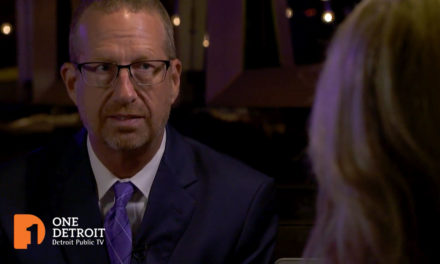When Jonathan Harris first previewed his painting “Critical Race Theory” at his TRIPTYCH: Stronger Together exhibit at the Irwin House Gallery in Novemeber 2021, it sat on a wall just outside the gallery’s main room, but despite its less-than-prominent placement, it sold easily. It was the first step toward a virality that swept over Harris’ painting and sparked a national conversation about critical race theory and the ways social and political issues are taught in America’s classrooms.
RELATED: Irwin House Gallery Features Detroit Artists in TRIPTYCH Exhibit
“Critical Race Theory,” which depicts the white-washing of Black history, began its viral journey when The Other 98%, a nonprofit focused on social justice, shared Harris’ painting with their nearly 6.5 million followers. Then, the Oklahoma City chapter of Black Lives Matter shared the image, garnering thousands more shares and spreading the painting across the globe. One Detroit’s Bill Kubota met up with Jonathan Harris in Detroit on signing day, where he signed and sold out of 250 prints of the painting, to discuss his painting’s swift rise to global acclaim and share what he thinks about critical race theory in the classroom.
Full Transcript:
Bill Kubota: December 2021, signing day for Jonathan Harris. It’s for one of his paintings on display, but not for sale. These art collectors at Noni’s Sherwood Grille in Detroit want their own numbered and autographed print.
David Mays, Art Collector: It was done this year earlier in 2021, the name of this painting is CRT. This is a limited-edition print, CRT standing for critical race theory, a topic of discussion that has permeated through our culture in our community. I think the importance of a painting like this during this time can’t even be verbally expressed.
Bill Kubota: Harris, a young emerging artist now in the national spotlight, arts, journals, newspapers, cable TV. He started painting seriously just a couple of years ago.
Jonathan Harris, Artist: I have been drawing and painting my whole life. I never have really taken a serious. I went to school for graphic design, and I was just looking for another outlet to express myself, so I started to paint. I started painting celebrities and different people I could just Google online.
Bill Kubota: Someone told Harris celebrity paintings might not be the best path to success for an artist.
Jonathan Harris: That’s how I got into painting my story and things I see and was also passionate about. This is the far left, hear no evil, the middle, see no evil, and the right, speak no evil. It’s basically just telling a story about how I feel in America.
Jonathan Harris: OneDetroit last talked to Harris in November for his exhibition at Detroit’s Irwin House Gallery.
Misha McGlown, Director, Irwin House Gallery: We had been speaking with Jonathan about doing a solo exhibition of his work, and he felt that he wasn’t ready to do that. I believe he was ready to do that. So, he saw this as an opportunity not just for himself, but to also bring in to other emerging artists that he had met, whose work he felt passionate about.
Bill Kubota: Opening night in the hallway off the main room, there was critical race theory. It sold immediately. Who else knew it would go over so big at the time?
James Dozier, Artist/Art Collector: And so, we are here to witness the signing of these prints by Jonathan, and to further encourage him to continue exploring social-political issues in his artwork. He’s an artist who I feel is very, very skilled in exploring this aspect of our society.
David Mays: I’m happy to be an owner of the first copy of this print, and I can’t wait to frame it and hang it. So, thanks a lot, Jonathan Harris, I really appreciate it.
Bill Kubota: Did you think it would catch on the way it did?
Jonathan Harris: I didn’t think that it would catch on like this. I still lack like that like the art confidence. So, I just don’t think it would catch on like this, but it’s a blessing, you know. I’m just excited that, you know, the conversation is being had, especially right now.
Bill Kubota: Critical race theory. The idea popped up in the news, then anti-critical race theory protests came to school boards last year. Like most of America, that’s when Harris learned about the CRT fight too, the painting came soon after.
Jonathan Harris: And I was just talking to somebody at the show about the piece. The person had said, You know, I see you painted Martin Luther King and Malcolm X, but why did you paint on Aunt Jemima? And the person was serious.
Bill Kubota: Harriet Tubman rendered in black and white, matching an image more of us should know about, escaped slave champion of the Underground Railroad, and much more.
Jonathan Harris: A couple of people ask me why Harriet Tubman not smiling because she in the front. It’s like, you know, what was there to smile about? I’m a slave.
Bill Kubota: Hope for more awareness of Tubman, President Obama ordered her based on the U.S. $20 bill in 2016. Didn’t happen under the last president, perhaps on track with our new president.
Jen Psaki, White House Press Secretary: We’re exploring ways to speed up that effort, but any specifics would, of course, come from the Department of Treasury.
Bill Kubota: No action from Treasury yet.
Jonathan Harris: And this road behind here is important too because this represents the role that African Americans already traveled; everything we already went through. And that’s why it’s not no sunshine back there, it’s not no trees, it’s not no, nothing happy. You know, it kind of actually, you know, looks sad, like a real dreary kind of a day. Just a dirt road and some dried grass; it wasn’t pretty.
Bill Kubota: Fine art with a direct message. Received conceptually, in posters, some capturing a time on canvas like Spain 1937. Or right here right now, with critical race theory. It might bring to mind, “The problem we all live with”, by Norman Rockwell Back in the 60s, inspired by Ruby Bridges. Relevant again, with concern in some Tennessee schools about a book telling Bridges story.
Jonathan Harris: I want to, you know, just the casual person, if you’re not into art or whatever it may be, to just look at it, and it catches your attention and you have the question of, Hey, what’s going on here? Then say, Oh, critical race theory. Oh, what is that? Oh, you know, this is going on in the south right now or slowly making his way up to the higher states.
Bill Kubota: Most of the painting, a whitewash depicting a future that stops just near the top.
Jonathan Harris: So, this figure right here, he represents the America trying to cover up our history.
Bill Kubota: Chronologically speaking, Harris has us now at the bottom of the canvas.
Jonathan Harris: It’s right here now and eventually is going to be here. And then the more years are going to be here and then here and then here. And then we could look, a hundred years from now or even less, and say, the talk would be, oh, you know, why do we get to teach about Harriet Tubman if we didn’t have to teach about this figure? or we now have to teach about Marcus Garvey? Any other historical figures down here, or stories, or things that happen, are covered up by America because it doesn’t make the kids feel good knowing what their ancestors were capable of and that’s not fair.
James Dozier: And he has just distilled that whole idea of what they’re trying to do in this magnificent painting.
Jonathan Harris: I don’t think that we going to be done with this anytime soon. This whole critical race theory thing, it’s a beast that’s never gone be full. It’s just going to keep going and growing and growing and growing, and years from now or generations from now, they may get up to the point and say, hey, you know, we don’t need to teach the kids about Martin Luther King or Malcolm X or Harriet Tubman; that’s what this piece is about.
Subscribe to One Detroit’s YouTube Channel & Don’t miss One Detroit Mondays and Thursdays at 7:30 p.m. on Detroit Public TV, WTVS-Channel 56.
Catch the daily conversations on our website, Facebook, Twitter @DPTVOneDetroit, and Instagram @One.Detroit
View Past Episodes >
Watch One Detroit every Monday and Thursday at 7:30 p.m. ET on Detroit Public TV on Detroit Public TV, WTVS-Channel 56.




